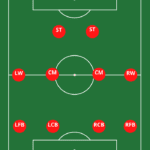- Last Updated -
Role of Inverted Wingers
The Changing Role of ‘Inverted Wingers’ – Soccer, known as the beautiful game, has evolved tremendously over the years. Alongside these changes, player roles and positions have also undergone a significant transformation.
One such role that has captured the attention of coaches and fans alike is that of the ‘inverted wingers.’ These players bring a unique style to their respective teams, challenging traditional conventions and adding a touch of unpredictability to the game.
Definition of ‘Inverted Wingers’ in soccer
An inverted winger, also known as an inside forward or an inverted forward, is a player who operates on the opposite side of their natural foot. In simpler terms, if a right-footed player is deployed on the left flank or vice versa, they are considered an inverted winger.
This positioning allows them to cut inside towards the central areas rather than hugging the touchline like traditional wingers. What sets inverted wingers apart from their traditional counterparts is their intent to drift infield and wreak havoc within congested central spaces.
They look to exploit gaps between defenders and midfielders rather than rely solely on delivering crosses from wide areas. This crafty tactical approach challenges defenses by forcing them to adapt and adjust their shape accordingly.
A brief history of the role and its evolution
The concept of inverted wingers can be traced back to Dutch football in the 1970s with Total Football pioneer Johan Cruyff. During his time at Ajax and later at Barcelona as a manager, Cruyff experimented with players like Jesper Olsen and Marc Overmars who operated on opposite flanks based on their strong foot preferences.
Over time, more coaches recognized the potential benefits that these unconventional wide players brought to their teams.
The role gained further prominence during Pep Guardiola’s reign at Barcelona in the late 2000s, where he deployed Lionel Messi as a false nine or a central striker, even though Messi naturally played as a right-winger.
This tactical shift showcased the effectiveness of utilizing inverted wingers to create space and goal-scoring opportunities. Since then, the role of inverted wingers has flourished across various leagues worldwide.
Players such as Arjen Robben, Franck Ribery, and Gareth Bale have left an indelible mark on the game with their ability to cut inside and wreak havoc on opposition defenses.
As tactics continue to evolve and teams seek new ways to unlock defenses, the role of inverted wingers in modern soccer remains as captivating as ever.

The Evolution of Winger Roles
Traditional wingers and their characteristics
In the olden days of soccer, wingers were seen as speedsters whose main objective was to stay glued to the touchline, hugging the flank like a loyal GPS. These traditional wingers were blessed with electrifying pace and blessed us with memorable moments of blistering runs down the wing.
They were expected to deliver accurate crosses into the box for their teammates to pounce upon and score delightful goals.
These charismatic players possessed incredible dribbling skills that allowed them to navigate past defenders with ease. Their ability to leave fullbacks gobsmacked made them crowd favorites, providing much excitement for fans.
Additionally, traditional wingers were often characterized by their one-dimensional style of play, rarely venturing into central areas or trying anything outlandish. They stuck religiously to their designated zones, like disciplined soldiers following orders.
The emergence of inverted wingers and their impact on tactics
Enter the era of inverted wingers – a revolution in soccer tactics that turned tradition on its head (or rather, its wing). Coaches and tactical masterminds began experimenting with players who could invert their positions by cutting inside from wide areas towards central zones.
This unexpected twist had a profound impact on how teams approached attacking strategies.
The advent of inverted wingers injected new dynamism into team play as it unleashed a concoction of confusion for defenders on both flanks. Suddenly, opposition fullbacks found themselves dealing not only with wide threats but also puzzling central runs that disrupted defensive structures.
This strategic modification made it harder for defenders to anticipate where the danger would strike from next. Furthermore, this change in winger roles forced teams to adapt tactically.
Midfielders had to adjust their positioning and support these newfound central threats adequately. The emergence of inverted wingers created more versatility within teams, as it added an additional layer of unpredictability and opened up new avenues for attacking options.
It was a tactical revolution that forever altered the way teams approached the beautiful game. Stay tuned for section 3, where we will delve deeper into the tactical advantages of inverted wingers and how their versatility transformed the game!

Tactical Advantages of Inverted Wingers
Creating space for overlapping fullbacks: Exploiting defensive gaps
Inverted wingers play a vital role in creating space for overlapping fullbacks, causing chaos among the opposing team’s defense. With their ability to cut inside from wide positions, they force the opposition’s fullbacks to make crucial decisions.
As inverted wingers drift towards the center, it naturally lures the opposing fullbacks inward, leaving gaps on the flanks. This opens up valuable opportunities for their own team’s fullbacks to make overlapping runs into those vacated wide areas.
These overlapping runs exploit defensive gaps and pose a significant threat to opposition defenses. The inverted winger’s movement pulls defenders out of position and forces them to adjust their positioning quickly.
Defenders are caught between marking both the inverted winger cutting inside and tracking the advancing fullback on the flank. This creates confusion in the defense, making it easier for attackers to find spaces to exploit and create goal-scoring opportunities.
Increased attacking options from wide areas: Unleashing creativity
One of the key advantages of utilizing inverted wingers is their ability to provide increased attacking options from wide areas. Traditionally, wingers were expected to hug the touchline and deliver crosses into the box.
However, inverted wingers offer a more diverse attacking threat by cutting inside instead of staying wide. By moving infield, they have more freedom and flexibility in decision-making.
They can dribble past defenders or unleash deadly accurate shots from central positions that catch defenders off guard.
This unpredictability makes them harder to defend against as they are not restricted solely to crossing situations but also possess a variety of techniques that can be used depending on different scenarios during matches.
Cutting inside: Linking up with central midfielders for intricate passing moves
When inverted wingers cut inside from wide areas, not only do they create goal-scoring opportunities for themselves, but they also enhance the team’s ability to link up with central midfielders for intricate passing moves.
This interplay between inverted wingers and central midfielders can unlock even the tightest defenses.
By cutting inside, inverted wingers provide an additional passing option in congested central areas. Their ability to navigate through tight spaces with quick changes in direction and close ball control allows them to receive the ball from central midfielders and progress play.
This dynamic collaboration often leads to beautiful passing combinations that dissect opposition defenses, allowing the team to penetrate more effectively. Inverted wingers offer multiple tactical advantages in modern soccer.
They create space for overlapping fullbacks by exploiting defensive gaps caused by their inward movement. Additionally, they provide increased attacking options from wide areas due to their ability to cut inside and unleash shots or dribbles that catch defenders off guard.
Moreover, their propensity for linking up with central midfielders opens up new dimensions of intricate passing moves that can break down stubborn opposition defenses.
As the role continues to evolve, teams will undoubtedly continue harnessing the potential of these versatile players who redefine traditional winger positions on the field.

Key Skills and Attributes of Inverted Wingers
Strong Dribbling Ability to Navigate through Congested Central Areas
Inverted wingers possess a remarkable dribbling ability that allows them to navigate through congested central areas with ease. With defenders often crowding the middle of the pitch, the ability to dribble effectively becomes crucial for these players.
They employ quick changes in direction, employing feints and sudden bursts of speed to leave defenders trailing in their wake. By slipping past opponents in tight spaces, inverted wingers create opportunities for themselves or their teammates by drawing defenders out of position.
Vision and Passing Accuracy for Effective Link-Up Play
One of the defining characteristics of inverted wingers is their excellent vision and passing accuracy. These players possess a heightened awareness of their surroundings, enabling them to spot openings in crowded central areas that others might miss.
Their ability to pick out a teammate’s run or precisely slot through balls into tight spaces is nothing short of artistry on the field. This skill allows them not only to link up seamlessly with their fellow attackers but also provides an additional dimension to their team’s attacking play.
Precise Through Balls to Unlock Defenses
Inverted wingers excel at playing precise through balls that can unlock even the most stern defenses. Their astute reading of the game combined with exceptional passing accuracy enables them to dissect opposition backlines effortlessly.
Whether it be a perfectly weighted lofted pass over the defensive line or a laser-like ground ball splitting two center-backs, inverted wingers have mastered this technique.
By exploiting gaps between defenders or releasing teammates behind enemy lines, they give their team that extra edge needed for goal-scoring opportunities.
These key skills and attributes distinguish inverted wingers from traditional wide players on the soccer field. Their strong dribbling ability, quick changes in direction, and close ball control enable them to navigate through congested central areas effortlessly.
Moreover, their exceptional vision and passing accuracy allow for effective link-up play, as they can spot openings in crowded central areas and deliver precise through balls to unlock defenses.
Inverted wingers are not just skilled individuals but also tactical masterminds who redefine the role of wide players in modern soccer.

Adaptations by Opposing Teams
Defensive strategies to neutralize inverted wingers
Opposing teams have devised various defensive strategies to stifle the influence of inverted wingers on the game. One effective tactic is to employ a narrow defensive block, clogging up the central areas of the pitch.
By denying space centrally, teams aim to force inverted wingers toward the sidelines, where they are less dangerous.
This approach restricts their ability to cut inside and limits their options for penetrating through the heart of the defense. To counteract the threat posed by inverted wingers, teams also opt for physically imposing defenders with good positional sense.
These defenders have the strength and discipline needed to handle confrontations with these tricky attackers. By sticking close and applying physical pressure, they effectively disrupt their rhythm and minimize their impact on the game.
Exploiting potential defensive weaknesses caused by inverted wingers
While inverted wingers can wreak havoc on opposition defenses, their aggressive positioning can leave gaps that opponents can exploit. One common method is through quick counter-attacks into vacated wide areas.
When an inverted winger drifts infield, it often pulls fullbacks or wide midfielders with them, leaving space out wide for fast-breaking opponents to exploit.
Savvy teams take advantage of this vulnerability by launching rapid attacks down those vacant flanks before defensive reinforcements arrive. Another weakness that arises from utilizing inverted wingers lies in targeting fullbacks who push forward frequently in support of these attackers.
With fullbacks committed higher up the pitch, spaces open up behind them which clever opponents can exploit through well-timed runs or incisive passes into those vacated areas. This strategic movement forces the opposition’s backlines to constantly adjust and remain wary of leaving gaps behind them.
While ‘inverted wingers’ have revolutionized modern soccer tactics with their ability to cut inside and create goal-scoring opportunities, opposing teams have adapted their defensive strategies to minimize their impact.
By deploying narrow defensive blocks and physical defenders, opponents aim to neutralize the central threat posed by these attackers.
At the same time, counter-attacking into wide areas and targeting fullbacks who venture forward provides an effective way to exploit potential vulnerabilities caused by these attacking players.
The ever-evolving cat-and-mouse game between inverted wingers and opposing teams continues to shape the dynamic nature of modern soccer.

Notable Players & Teams Utilizing Inverted Wingers
Cristiano Ronaldo’s Transformation from a Traditional Winger
When discussing the evolution of inverted wingers, one cannot ignore the impact of Cristiano Ronaldo. The Portuguese maestro burst onto the scene as a traditional winger during his early days at Manchester United.
He terrorized defenders on the flanks with blistering pace and mesmerizing dribbling skills.
However, as time went on, Ronaldo’s game underwent a remarkable transformation. Under the tutelage of Sir Alex Ferguson and later at Real Madrid, Ronaldo honed his ability to cut inside from wide positions.
This alteration in his playing style allowed him to exploit central areas more effectively and become an even deadlier goal threat. His move from traditional winger to inverted winger showcased his adaptability and willingness to embrace tactical changes for the benefit of his team.
Conclusion
The changing role of inverted wingers in modern soccer is a testament to the dynamic nature of the sport. As tactics evolve, players must adapt their styles accordingly to stay effective on the pitch.
The utilization of inverted wingers has revolutionized attacking play by creating new dimensions and opportunities within games. While this shift may have initially been met with skepticism, it has undeniably breathed new life into soccer.
It has enhanced creativity, increased goalscoring avenues, and added an extra layer of complexity for teams both in attack and defense. As teams continue to experiment with tactical approaches, we can expect more thrilling performances from these versatile players who redefine what it means to be a modern footballer.
So let us embrace this evolution with open arms as it pushes soccer into exciting new territories where skillful players roam freely and imaginative tactics are celebrated.
The changing role of inverted wingers is just one example among many that demonstrate how soccer constantly evolves while remaining true to its essence – a beautiful game that captivates fans all over the world.
Understanding the Six Soccer Defensive Positions
In this article, focused on six defensive positions: goalkeeper (GK), sweeper (SW),...
Read MoreNutmeg in Soccer, Soccer’s Sneakiest Move
Soccer is an incredible sport with numerous skills and techniques that make...
Read MoreSoccer Position Abbreviations – A Beginners Guide
Hey there! You've landed on "Decoding Soccer Positions: A Rookie's Handbook". This...
Read MoreSoccer Halftime: How Long Is It?
Halftime in FIFA and MLS matches is a fixed duration of 15...
Read MoreWhat is a Set Piece in Soccer?
What is a set piece in soccer? Introduction Soccer is a sport...
Read MoreHandball Rule In Soccer – Law #12
Soccer is one of the most popular sports globally, with millions of...
Read MoreThe Highest Scoring Games In Soccer History
Phew, after reading about the seven worst blowouts in soccer history, I...
Read MoreThe Ultimate Guide to Soccer Field Size
How big is a soccer field? Read this post and get a...
Read MoreBest Youth Soccer Cleats for 2024 : Top 5 Pick
Welcome to our comprehensive guide on the best youth soccer cleats for...
Read MoreBest Grip Socks For Soccer 2024
In this post, we present the best grip socks for soccer, so...
Read Moresoccer position numbers quick guide
Each player on the field has an important job as it relates...
Read MoreBest Soccer Cleats for Turf 2024
What are the Best Soccer Cleats for Turf Fields? Look no further...
Read More5 Best Soccer Cleats For Speed In 2024
Our Top 5 Picks for the Best Soccer Cleats for Speed in...
Read MoreBest Soccer Cleats for Women In 2024: Top 5 Picks
The Best Soccer Cleats for Women in 2023: Top 5 Picks The...
Read MoreThe Mercy Rule In Soccer And The Roll It Plays
Picture this: a soccer match, with one team dominating the field and...
Read MoreWhat is a soccer tackle?
The Importance Of Mastering Tackling Skills For Success In Soccer To succeed...
Read MoreMastering Soccer Jargon: A Glossary for Fans and Players
Last Updated on August 27, 2024 by Andy Long Mastering Soccer Jargon:...
Read MoreChoosing the Right Soccer Ball Size by Age
Soccer is undeniably one of the most popular sports in the world,...
Read MoreSoccer Substitution Rules: The Strategic Art of Changing the Game
Soccer, known as the beautiful game worldwide, has seen various changes to...
Read MoreCan Soccer Cleats Be Used For Baseball?… Pros and Cons…
Soccer and baseball are two different sports that require specific types of...
Read MoreMastering the 4-3-3 Soccer Formation
Here Are Some Teams That Have Mastered the 4-3-3 Soccer Formation -...
Read MoreThe Sweeper Soccer Position: A Versatile and Dynamic Role
The sweeper position was popularized in the 1960s and 70s by the...
Read MoreBest Soccer Cleat Insoles 2024
What are the Best Insoles For Soccer Cleat? Are you a serious...
Read More5 Best Soccer Cleats For Strikers in 2024
What are the Best Soccer Cleats for Strikers? The beautiful game of...
Read MoreSoccer Overtime Rules: Everything You Need to Know
Introduction: Overtime Soccer Rules Everything You Need To Know Soccer is a...
Read MoreSoccer History USA: From Struggles to Successes
Soccer, also known as football, is the world's most popular sport, with...
Read MoreSoccer Goal Size and Dimensions
Brief History of Soccer Soccer has been played in various forms throughout...
Read MoreDiscover the 5 different types of soccer cleats
Introduction - A brief overview of the importance of choosing the right...
Read MoreWhat is a clean sheet in soccer?
The Importance of Keeping a Clean Sheet: An Introduction to Soccer's Most...
Read MoreBest Soccer Cleat Insoles – VKTRY Insoles
Try VKTRY Insoles to Improve Your Athletic Performance Now, let's delve into...
Read MoreHow Many Soccer Games In A Season
The number of soccer games in a season varies depending on the...
Read MoreWhat is a Soccer Assist?
The Importance of Teamwork in Soccer The importance of teamwork in soccer...
Read MoreDo Grip Socks Help In Soccer?
Do Grip Socks Help In Soccer? The Importance of Footwear in Soccer...
Read MoreSoccer’s Attacking Midfielder And The Crucial Role It Plays
The attacking midfielder position in soccer is a vital role that requires...
Read MoreSoccer Position # 4 Center Back Explained
Center Back in soccer is the # 4 Position, also known as...
Read MoreThe Golden Era of Italian Soccer in the 1990s
A Glimpse into Italy of the 90s: Culture, Politics, and Soccer As...
Read MoreThe Impact of VAR on Modern Soccer: Video Assistant Referee
Traditional Refereeing Methods: Balancing Act on the Pitch In the realm of...
Read MoreBest Soccer Backpacks 2024
Soccer demands that you carry gear, such as balls, cleats, uniforms, water...
Read MoreMastering the 4-4-2 Soccer Formation
The 4-4-2 soccer formation is one of the most popular formations used...
Read MoreThe Power of a Goal in Soccer, How it Influences The Game
Football, commonly known as soccer, has established itself as a globally renowned...
Read More




































